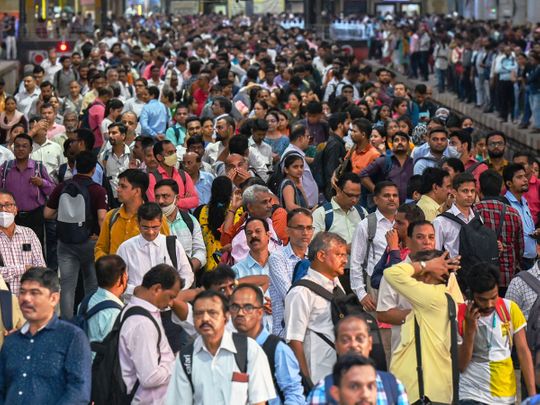
“India has overtaken China…” Regardless of how that sentence ends, it would normally make Indians happy. But a cartoon in the leading German magazine, Der Spiegel, has many prominent Indians associated with the Narendra Modi government, including ministers and senior BJP leaders, all riled up. Why? Because it shows a beaten down Indian train, chock-a-block with people, with many even stacked on top of it, chugging past a sleek Chinese bullet train, with only two drivers visible inside its engine compartment.
The context of the cartoon is a United Nations report that India’s population of nearly 1.426 billion has now surpassed China’s. The UN has only confirmed what many have believed for the last few years — that India is already the most populous country in the world. This was bound to happen with China’s strict enforcement of its one-child policy for several decades. Declining fertility coupled with economic prosperity means the cost of having and rearing children has also increased in China. Couples get married later and do not wish to have many children despite the one-child policy being replaced with incentives for those who have more children.
Population control measures
India, whose economy is an estimated one-fifth of China’s, has never enforced such strict controls on the number of children a couple can have. However, in the decades after independence, family planning was heavily promoted by the state. Hum do hamare do — We two, ours two — was the popular slogan to discourage people from having more than two kids. Free condoms, manufactured by the government-owned Hindustan Latex Ltd., were distributed through healthcare outlets.
The birth rate, however, did not go down as speedily as the government desired. Why? Because as the witty adage goes, “Development is the best contraceptive.” As India began to do well after the liberalisation of the economy in the 1990s, the birth rates also went down dramatically. Especially among the middle and better off classes. It is only a matter of time, when Indian growth rates will also begin to decline after its population peaks around. In other words, India too will follow global trends in population stabilisation, even decline, in the decades ahead. No doubt feeding the equivalent of an entire extra Australia each year will be a challenge, but India seems well poised to meet it. We are a food surplus and exporting nation now.
There is a general perception that India’s rise is intolerable to the erstwhile colonial powers, who do not hesitate to mock and deride us whenever possible.
To return to the comparison with China, the latter’s population was around 540 million in 1950 to India’s 350 million. In less than 75 years, India has caught up and overtaken China. In another 75 years, around the beginning of the next century, India’s population is estimated to be 1.53 billion, while China’s will have declined to 770 million. Unlike the gloomy forecasts of pessimistic Malthusians, India will be in an even better position than it is today, not only to take care of its people but also to supply manpower and services to the world. In fact, it is China, Russia, Japan, and most European states, including Germany, who will need to worry about their declining populations.
Given such a scenario, one wonders why the BJP is so touchy about a single cartoon. A senior media adviser tweeted, “Hi Germany, this is outrageously racist. Der Spiegel caricaturing India in this manner has no resemblance to reality. Purpose is to show India down and suck up to China.” The minister of electronics and information technology, Rajeev Chandrasekhar, also lashed out, “Dear Cartoonist at @derspiegel… Notwithstanding your attempt at mocking India … it’s not smart to bet against India under PM @narendramodi ji…. In a few years India’s economy will be bigger than Germany’s.”
‘Conspiracies against India’
Criticism from abroad seems to bother the ruling regime. Prime Minister Narendra Modi himself has said, “These days there are conspiracies against the nation. They are trying to malign the image of Indian tea worldwide. Some documents have revealed that such conspiracy is being hatched by forces sitting in a foreign land.” There is a general perception that India’s rise is intolerable to the erstwhile colonial powers, who do not hesitate to mock and deride us whenever possible. Indeed, there is little doubt that mainstream Western media continues to portray India, not to speak of Modi and the BJP, in a poor light.
Senior leader and BJP national Vice-President, Baijayant Panda, accused the Western media of ignoring India’s progress, singling out a leading New York daily for “routine India bashing.” Perhaps, he was referring to a 2014 cartoon showing an Indian farmer, with his cow, knocking at the door of the “Elite Space Club,” which India had joined after sending a satellite into orbit around Mars. The newspaper in question published an apology.
My view of the present fracas and fuss over the Der Spiegel cartoon is that rather than attacking it, all guns blazing, it would be better to consider it beneath contempt by ignoring it altogether. Or, better still, what prevents us from generating cartoons mocking the mockers. Why should government ministers and officials stoop to pay so much attention to such a trivial thing as a cartoon in a German-language magazine that no one reads in India and few have even heard of?
Pushing back against trivia from the West or oversensitivity to criticism from one’s colonial masters shows how dependent we are on their good opinion. Instead, a better sign of being decolonised would be to stop bothering about what the West thinks of us. Which is what the Indian masses are already doing as they go about their own business. As India’s progress becomes more and more evident, even incontrovertible, the world’s recognition is also bound to follow. Trying to control other peoples’ perception of us smacks of “China envy,” not suited to a democracy and open society like India.
Returning to the cartoon in question for a closing quip, how come those offended didn’t notice how proudly the Indian flag was furled on the overcrowded train? Even more importantly, how happy and relaxed Indians looked compared to the two astonished Chinese train drivers.







_resources1_16a45059ca3_small.jpg)

